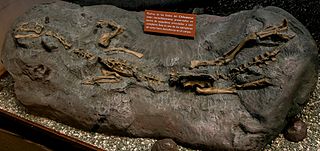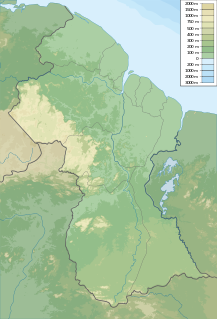 W
WThe Arcabuco Formation is a geological formation of the Altiplano Cundiboyacense, Eastern Ranges of the Colombian Andes. The formation consists of thick beds of light-coloured quartzitic sandstones and conglomerates with occasional shales and dates to the Late Jurassic and Early Cretaceous periods; Tithonian to Berriasian epochs. Dinosaur footprints have been found in the Arcabuco Formation near the Iguaque anticlinal outside Chíquiza, Boyacá.
 W
WThe Areado Group is a Late Jurassic to Early Cretaceous geologic group in southeastern Brazil. The group was defined by Cardoso in 1968.
 W
WThe Baños del Flaco Formation is a Late Jurassic to Early Cretaceous (Tithonian to Berriasian geologic formation in central Chile. The formation comprises limestones and sandstones deposited in a shallow marine to fluvial environment. Fossil ornithopod tracks have been reported from the formation.
 W
WThe Cañadón Asfalto Formation is a Middle Jurassic to Late Jurassic geologic formation, from the Jurassic period of the Mesozoic Era. Its age is controversial, uranium-lead dating of the volcanic tuff beds having given various different ages. Recent work suggests that the base of the formation was formed around 171 Ma, during the upper Aalenian, while the main age for the Lower Las Chacritas Member being around 168 Ma, during the Bajocian, Bathonian and Callovian While the overlying Puesto Almada Member seems to be around 158 ma, or Oxfordian age.
 W
WThe Cañadón Calcáreo Formation is an Oxfordian to Kimmeridgian-aged geologic formation, from the Cañadón Asfalto Basin in Chubut Province, Argentina, a rift basin that started forming since the earliest Jurassic. It was formerly thought to date into the Cretaceous, but the age has been revised with Uranium Lead dating as likely being solely Late Jurassic in age.
 W
WThe Canon del Colorado Formation is an Early Jurassic geologic formation in the San Juan Province of Argentina. The formation comprises conglomerates and claystones and is exposed in the Sierra de Mogna. Dinosaur remains are among the fossils that have been recovered from the formation; Adeopapposaurus.
 W
WThe Cerro Carnerero Formation is a geological formation of the Golfo San Jorge Basin in Chubut Province, Patagonia, Argentina.
 W
WThe Chacarilla Formation is an Oxfordian to Early Cretaceous geologic formation of the Tarapacá Basin in northern Chile, close to the border with Bolivia. The marine and fluvial formation preserves several dinosaur trackways and has been declared a Natural Sanctuary in 2004.
 W
WThe Chon Aike Formation is an extensive geological formation, present in the Deseado Massif in north-central Santa Cruz Province, Patagonia, Argentina. It covers an area of approximately 100,000 square kilometres (39,000 sq mi) and consists of rhyolitic volcanic rocks, particularly ignimbrites and lavas, with smaller amounts of agglomerates and tuffs. Within dacitic rocks, plant fossils have been found.
 W
WThe Coihaique Group is a group of geological formations in northwestern Patagonia. From top to bottom the formations that make the group are Apeleg, Katterfeld and Toqui. The contact between the formations of the group are diachronous with Katterfeld Formation interfingering with the formations on top and below it. The lower and upper boundaries of the group are unconformities formed by erosion. The older parts of Coihaique Group represent a marine transgression while the younger parts evidences a return to non-marine conditions.
 W
WThe Girón Formation is an extensive geological formation stretching across 325 kilometres (202 mi) from the north in Teorama, Norte de Santander, across the Mesa de Los Santos and Chicamocha Canyon towards west of Nobsa, Boyacá in the northern part of the Altiplano Cundiboyacense in the south. The formation extends across the northern and central part of the Eastern Ranges of the Colombian Andes.
 W
WThe Guavio Formation is a geological formation of the Altiplano Cundiboyacense, Eastern Ranges of the Colombian Andes. The formation consists of conglomerates, shales and limestones, dates to the Late Jurassic and Early Cretaceous periods; Tithonian to Berriasian epochs and has a maximum thickness of 1,000 metres (3,300 ft).
 W
WThe La Puerta Formation is a Late Jurassic to Early Cretaceous geologic formation of southern Bolivia. The fluvial and eolian sandstones preserve ichnofossils of Theropoda indet., Thyreophora indet., Ankylosauria indet. and Stegosauria indet. at the Tunasniyoj tracksite. The formation is possibly a distal extension of the Botucatu Formation. The Tunasniyoj assemblage is the oldest dinosaur tracksite for Bolivia, and includes the oldest known evidence assigned to ankylosaurs and stegosaurs for South America.
 W
WThe La Quinta Formation is a Jurassic geologic formation which crops out in the Cordillera de Mérida and Serranía del Perijá of western Venezuela and northeastern Colombia. The formation is also present in the subsurface of the Cesar-Ranchería and Maracaibo Basins. At its type locality near La Grita, Táchira, it consists of a basal dacitic tuff followed by interlayered sandstones, tuffs, siltstones and rare limestones. Dinosaur remains including Laquintasaura, and Tachiraptor, are among the fossils that have been recovered from the formation.
 W
WThe Los Molles Formation is a geologic formation of Early to Middle Jurassic age, located at northern and central part of Neuquén Basin at Mendoza Shelf in Argentina. It is overlain by the Niyeu–Lajas Formation.
 W
WThe Lotena Formation is a geologic formation dated from the Late Callovian to Early Oxfordian in the Neuquén Basin in Mendoza Province, Argentina. The formation, first defined by Weaver in 1931 and named after Cerro Lotena, consists of fluvial conglomerates, calcareous sandstones and marine limestones and shales. The Lotena Formation is overlain by the La Manga Formation and overlies the Lajas Formation of the Cuyo Group. Initially, the fossil find of the pterosaur Herbstosaurus pigmaeus was reported from the formation, but this fossil was found in the younger Vaca Muerta. The formation is a reservoir rock in the Neuquén Basin.
 W
WLa Matilde Formation is a Jurassic geological formation in the Austral Basin of Santa Cruz Province, Patagonia, Argentina. It is dated to the Middle to Late Jurassic. From the Bathonian age to the Kimmeridgian age at the latest.
 W
WNacientes del Biobío Formation is a geological formation that crops out near the uppermost reaches of Bío Bío River, in south-central Chile, and nearby areas of Argentina. The formation is made up of basalt and pyroclastic rocks and marine sedimentary rocks, such as sandstone and mudstone. Some less abundant sedimentary lithologies are conglomerate, volcaniclastic sedimentary rock. The formation is intruded by Grupo Plutónico Galletué which is of Late Jurassic to Late Cretaceous age. Further north in Chile the formation is similar to Nacientes del Teno Formation while in Argentina it is similar to Los Molles Formation and Lotena Formation.
 W
WLa Negra Formation is a geologic formation of Jurassic age, composed chiefly of volcanic and volcaniclastic rocks, located in the Coast Range of northern Chile. The formation originated in marine and continental (terrestrial) conditions, and bears evidence of submarine volcanism as well as large explosive eruptions. The volcanism of La Negra Formation is thought to have lasted for about five million years.
 W
WThe Noreán Formation is a geological formation of the Eastern Ranges of the Colombian Andes, the Serranía de San Lucas and as basement underlying the southernmost Lower and northern Middle Magdalena Valleys. The formation consists of volcanic and pyroclastic lavas that range from andesites to rhyolites. Vitric, lithic and crystal tuffs and andesitic dikes and hypabyssal bodies are also present in the formation.
 W
WThe Pastos Bons Formation is a Late Jurassic geologic formation of the Parnaíba Basin in Maranhão, northeastern Brazil. The formation forms part of the sag phase of the basin. It overlies the Sardinha Formation and is overlain by the Mosquito Formation. The fluvial to lacustrine sandstones and shales have provided fossils of a coelacanth fish, Parnaibaia maranhaoensis and a paralligatorid named after the formation, Batrachomimus pastosbonensis.
 W
WThe Tacuarembó Formation is a Late Jurassic (Kimmeridgian) geologic formation of the eponymous department in northern Uruguay. The fluvial to lacustrine sandstones, siltstones and mudstones preserve ichnofossils, turtles, crocodylomorphs, fish and invertebrates.
 W
WThe Takutu Formation is a Late Jurassic geologic formation in Guyana and northern Brazil. The formation comprises sandstones deposited in a shallow water to littoral setting. Fossil theropod tracks have been reported from the formation. A paleobotanic analysis of drill cores of the formation was conducted by Thomas van der Hammen in 1966 and showed fossil Classiopolis flora.
 W
WTobífera Formation is a volcano-sedimentary formation of Middle to Late Jurassic age. The formation is crops out in the Magallanes Region in southern Patagonia and Tierra del Fuego of Chile, the Santa Cruz Province of southern Argentina, and in the subsurface of the Malvinas Basin offshore Argentina and the Falkland Islands.
 W
WThe Toqui Formation is a geological formation in the Aysén Region of southern Chile. It has been dated to the Tithonian stage of the Late Jurassic by uranium–lead dating of zircons, providing an age of 147 ± 0.1 Ma. It consists of an sequence of clastic sedimentary sandstones and conglomerates, interbedded with volcanic tuffs and ignimbrite. The dinosaurs Chilesaurus and indeterminate diplodocids are known from the formation. The formation was deposited in a fluvio-deltaic environment.
 W
WThe Vaca Muerta Formation, commonly known as Vaca Muerta is a geologic formation of Late Jurassic to Early Cretaceous age, located in the Neuquén Basin in northern Patagonia, Argentina. It is well known as the host rock for major deposits of shale oil and shale gas.
 W
WThe Valle Alto Formation is a geological formation of the Central Ranges of the Colombian Andes. The formation is composed of shales, sandstones and conglomerates and dates to the Late Jurassic period. Ammonites and fossil flora have been found in the Valle Alto Formation.